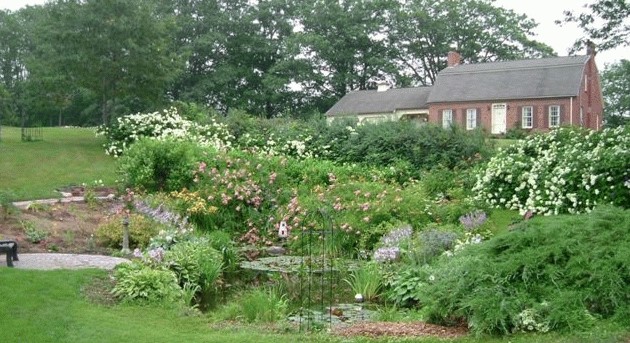
10488 Highway 1: The Mark Leonard House
10488 Highway 1: The Mark Leonard House
Architecture Style: Dutch Colonial Revival
Built: 1969
The east bank of the Leonard Brook was once known as “Haggai’s Landing”. It was historically the spot of a Mi’kmaq canoe landing at “the head of the tide”, where there was less change in water levels. It may have also been the site of a pre-Acadian summer encampment; when Mark and Marian Leonard excavated for their house, they found the perfectly preserved remains of an ancient campfire. We do know that it was a traditional stopping place. Before there was ever a “Post Road” or “Highway 1″, there was a ford over a shallow place in the Landing [Leonard] Brook, and a trail going back to the North Mountain from the “Leonard Corner”. The ford became a bridge, and the trail the Leonard Road “to the back settlement”, in 1802/3.
The landing helped because the Acadians had dammed the river. Dr. Frank Morse [unpubl.] wrote about meeting the elderly Mi’kmaq, Noel Labrador, one day in 1944 while he was fishing in the river. Noel asked him if he knew about the French Mill, and said, “You are standing in the intake for the mill pond right now” (10 feet east of the line between Robie Leonard’s and Harry Balcom’s.) Noel showed Dr. Frank a depression running southeast toward the river, ending in The Deep Hole, where once the dam had been. The mill pond remains (2005), and a slight elevation beside the pond shows where once the mill was located, according to Noel. The Acadians, superb engineers, knew how to dyke or dig to control the flood plain. The Acadian census of 1687/88 [Gargas – in Acadiensia Nova, by W.I. Morse], shows “Paradis Terrestre” or “Au Bout du Monde” with a single-family: 1 man, 1 woman, 1 boy under 15, 1 girl over 12, 3 girls under 12, 1 house, 7 horned cattle and 1 wool-bearing, 4 acres of marshland and 1 1/12 acres of upland cultivated, and 1 gun. The mill on Leonard’s farm and the cellars found north of the Post Road in Paradise, must have come later. Fred W. Bishop told Dr. Frank that this dam stood until a freshet in 1870 swept it away, creating “Peppermint Island” and some nearby rapids.
After the 1780s, Planter Jonathan Leonard and his wife Sarah [Dodge] occupied this land as part of their farm. The tombstone at the end of the lawn, dated 1802, marks their burial spot. Mark, Jonathan’s great-great-grandson and Marian [Bishop] built this gambrel-roofed house, with Marian as chief contractor and supervisor of the design and construction. Mark was justly proud of their home. In 2003, the year after his death, their daughter Barbara and husband Robert purchased the house and came to live with Marian.
| Owners | |
|---|---|
| Leonard, Mark/Marian | 1968- |
| Bishop, Robert/Barbara | 2003- |
